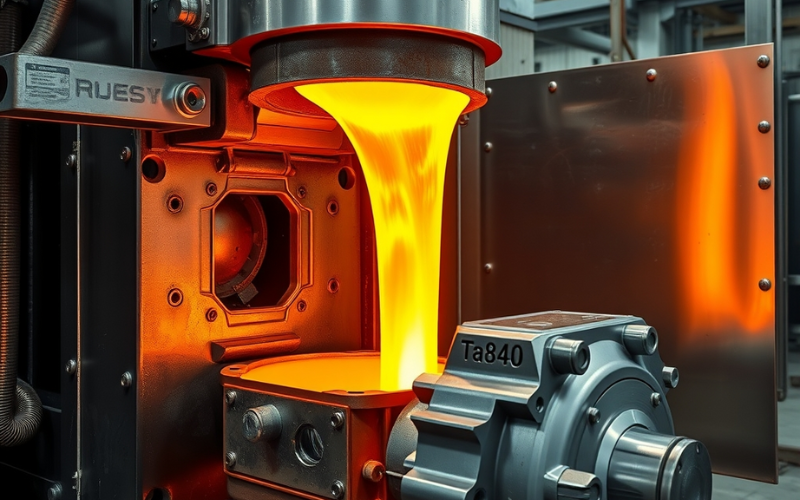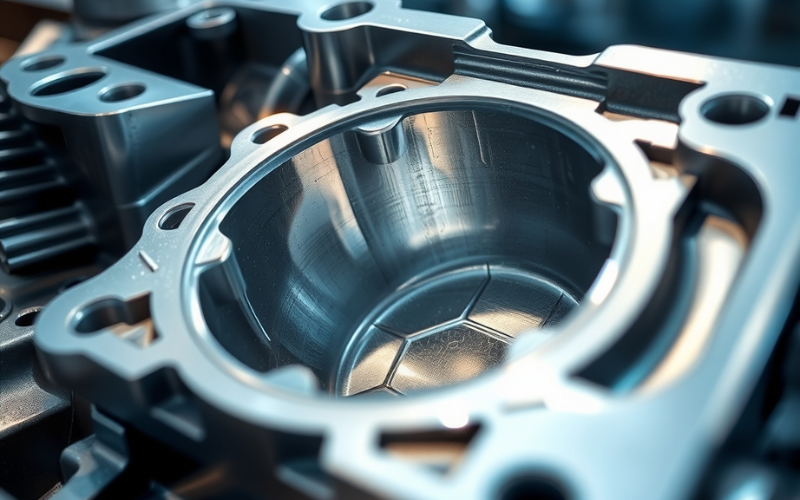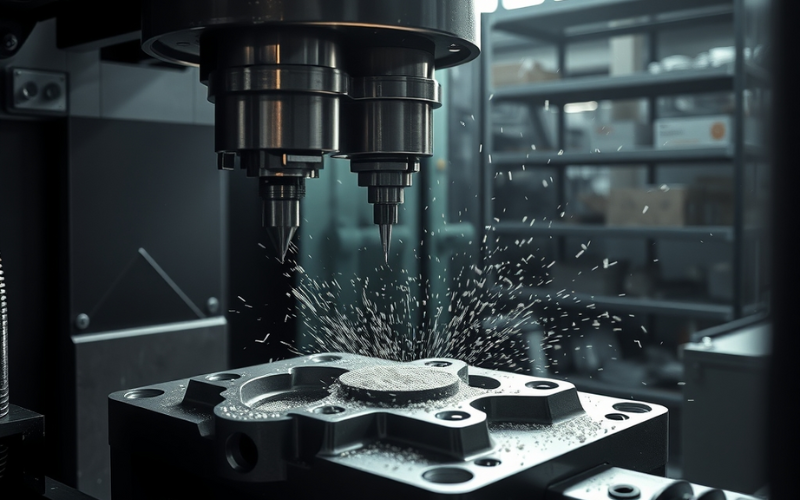Deixe a Istar ajudá-lo a iniciar o seu projeto com a nossa experiência e know-how!
Carregue os seus ficheiros de desenho e requisitos de produção e entraremos em contacto consigo no prazo de 30 minutos!

Die casting is a fast and great way of making things. In this guide to die casting, you will learn how the die casting process works. You’ll also see why it’s so helpful and what die casting materials are used. If you want to know how we make strong metal parts with tricky shapes for cars, toys, and tools, this article is for you. This is a look at the die casting work that makes so many things we use every day.
Let me tell you, the first time I saw a die casting machine, I was very impressed. Think about a very strong squirt gun. But instead of water, it shoots hot, liquid metal. And it’s not a toy, it’s a giant machine. That’s the main idea of die casting. Die casting is a way of making things that is used to create metal parts. Die casting is a process where hot liquid metal is pushed into a mold. This mold is called a die. This is done using high pressure. It’s a process used to produce metal parts with wonderful detail. This casting process is very common.
The “die” is a steel mold. It is made of two parts, or halves. When these halves are joined together, they make a space inside. This space is called the die cavity. It’s the perfect shape of the part we want to make. The molten metal fills the die cavity and then cools. It becomes a solid die cast part. This type of metal casting works very well. We use this specific die casting method to create metal parts for many different fields. Die casting is a metal casting process that has been used for a long time. It is a very trustworthy casting method. This casting is a process used for making many parts.
Die casting is one of the casting processes I’ve seen used the most. Why is that? Because this casting is fast and very exact. You can make thousands of parts that are the very same. Each die cast part is a perfect copy of the last one. This makes die casting wonderful for big projects. The final casting is strong and has a smooth feel. The die casting is used to make all sorts of things, from toy cars to parts for car engines. The whole die casting process takes careful planning, from the metal you pick to the mould design. This casting process makes top-quality die cast parts.
So, how does this all happen? The die casting process has a few main steps. It’s a bit like baking a cake, but you use hot metal and a strong machine. I’ll show you how die casting work is done. It’s a neat process to see.
Here are the simple steps of the die casting process:
This whole round of casting can happen very fast. For small parts, a die casting machine can do this hundreds of times in one hour. This makes the die casting process very good for making a large number of parts. It’s a great example of a casting process that works well.

When you talk about die casting, you will often hear about two main types of die casting. I have worked with both of them. Each one is good for different kinds of metal and different jobs. The two main methods of die casting are hot chamber die casting and cold chamber die casting. Both are types of high-pressure die casting. They both use high pressure to push metal into the die.
Knowing these two types of die casting is important for understanding the world of die casting. The biggest difference is how the liquid metal gets to the die. One machine has the furnace inside of it. The other machine has the furnace on the outside. Let’s look at a simple table to see how they compare.
| Caraterística | Hot Chamber Die Casting | Cold Chamber Die Casting |
|---|---|---|
| Where the Furnace Is | Inside the casting machine | Separate, outside the machine |
| Metal Used | Alloys that melt at low heat (Zinc, some Magnesium) | Alloys that melt at high heat (Aluminum, Magnesium) |
| How Fast it Works | Mais rápido | Mais lento |
| Pressão | Inferior | Mais alto |
Both hot and cold chamber die casting are important casting processes. The choice between hot and cold chamber die casting depends on the metal alloy you need for your die cast part. The die casting is a process that can be changed for what you need. The casting method is picked based on the metal.
The hot chamber die casting process is my favorite when I need to be fast. It’s a very smart design. In a hot-chamber die casting machine, the furnace is a part of the machine. The injection system is placed down inside the molten metal. That is why it’s called “hot chamber.” It is ready to work at any time.
Here is how this hot chamber process works. A plunger pushes a small amount of liquid metal. It goes through a nozzle and into the die. Because the furnace is part of the machine, the metal only has to go a short way. This makes the process very fast. The casting machine can do its job very quickly. This type of die casting is great for metals that do not melt at very high heat. It’s also great for metals that will not break the machine’s parts.
The metals used most often for hot-chamber die casting are zinc alloys. You will also see some magnesium alloy parts made this way. Hot chamber die casting is liked a lot because the die cast parts have a wonderful surface finish. The process also works very well. This type of casting is great for small die cast parts with a lot of detail. The hot chamber machine is a great tool for this kind of casting.
Now, let’s talk about cold chamber die casting. This is the strong one in the die casting world. It is used for metals with very high melting points, like aluminum. These types of metal would break a hot chamber machine. The cold-chamber die casting process is a little different.
In this die casting process, the furnace is not part of the casting machine. The metal is melted in a separate place. Then, a tool called a ladle carries the right amount of liquid metal. It pours the metal into the machine. Then, a strong plunger pushes the molten metal. It is injected into the die using high pressure. We call it cold chamber die casting because the metal is “cold” when it goes into the machine. It is still liquid, but it is not in a built-in furnace.
This process is a little slower than the hot chamber way. But it lets us use strong, light metals like aluminum for our die cast parts. This casting process is used for larger parts. Many car parts are made using cold chamber die casting. The pressures of the die casting are very high in this process. This process also makes very good die cast parts. The die casting and cold chamber method is a very useful way of making things.
Die casting is very important, but it’s not the only way to make metal parts. There are other casting processes. It’s good to know about them. That way, you can see what makes die casting special. Every casting method is good at something.
Here are a few other common casting processes:
Die casting is a kind of permanent mold casting. But using high pressure is what makes die casting so fast and correct. It’s a process that can be used for many things when compared to other casting processes.
So, why do so many people like die casting? I can tell you from my own time with it, there are many good reasons. The good things about die casting are big, especially when you need to make many parts. Die casting offer a lot of great things.
Here are some of the biggest good things about die casting:
Die casting is popular because of these reasons. The process also makes less waste metal. It’s a very smart way of making things. This casting method is really great for jobs that need a lot of parts. The die casting is also a good choice for parts that need to be both strong and not heavy.
The materials we use in die casting are very important. The kind of metal or alloy we choose changes the strength, weight, and price of the finished die cast part. The die casting materials we pick depend on what the part needs to do. Die casting uses different kinds of non-ferrous metals.
The most common die casting alloys are:
Picking the right alloy is a very important step. We think about how strong the die cast part needs to be. We also think about how it will be used and how much the metal costs. Die casting is a metal process that gives you a lot of material choices. This casting method can work with many different kinds of metal alloy.

So you have an idea for a part. How do you get it made? This is where die casting services can help. A good die casting company can help you with every step of the way. I’ve worked with many, and they are full of people who know a lot.
The process usually starts with your idea. You might have a drawing or a model on a computer. The first step is often CAD design. This means using a computer to make a perfect 3D model of your die cast part. This model is used for the mould design. The mould design is very important. It helps the metal flow well and makes a perfect casting.
The team at the die casting services company will then build the steel die. This can take a while because the die has to be very exact. When the die is ready, the casting can start. The company will handle the whole die casting process, from melting the metal to trimming the final casting. They make sure every die cast part is just what you wanted. They take care of the whole die casting journey. This is a complete way of making things.
If you are thinking about designing a part for die casting, I have a few tips for you. A little bit of planning can make a big difference. A good design makes the casting process go more smoothly and makes the die cast part better. These are simple design tips to keep in mind.
Thinking about these things during the CAD design step will give you a better die cast product. It’s all part of the planning that helps make a great casting.
I hope this guide to die casting was helpful. It’s a process that has been used for a long time, but it’s still one of the best ways to make great metal parts. Here are the most important things to remember about die casting: